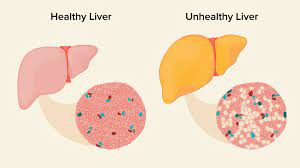In a groundbreaking study, researchers from Heinrich Heine University Düsseldorf (HHU), in collaboration with the German Diabetes Centre (DDZ) and other partners, have identified a critical factor contributing to fatty liver disease (steatotic liver disease, SLD). The study, published in the journal Nature Cardiovascular Research, reveals that a saturated fatty acid in blood vessels triggers the production of the signalling molecule SEMA3A, which effectively closes the ‘windows’ in blood vessels, hindering the transport of fat from the liver to adipose tissue.
Understanding MASLD
One particular form of SLD, known as ‘metabolic dysfunction-associated SLD’ (MASLD), is becoming increasingly prevalent due to adverse lifestyle factors such as high-energy diets and insufficient physical activity. MASLD affects about a third of the global population. Initially asymptomatic, MASLD can progress to liver inflammation, cirrhosis, liver failure, or even liver cancer over time. Unlike kidney failure, which can be managed with dialysis, there is no long-term substitute for liver function, making liver transplants the only cure for those severely affected.
Broader Health Implications
Individuals with MASLD are at a heightened risk of developing type 2 diabetes mellitus and are more likely to die from cardiovascular diseases. While obesity is a significant risk factor, MASLD does not exclusively affect obese individuals; even slim people can develop the disease.
The Role of SEMA3A
The molecular mechanisms behind MASLD are not yet fully understood. However, the researchers from HHU, DDZ, Düsseldorf University Hospital (UKD), and Forschungszentrum Jülich (FZJ) have identified a crucial aspect of its development. They found that tiny windows (fenestrae) in the endothelial cells of blood vessels, which facilitate the exchange of substances between liver cells and the bloodstream, are closed by the signalling molecule SEMA3A. This molecule is produced when blood vessels are exposed to the saturated fatty acid palmitic acid.
Key Findings
Using scanning electron microscopy, the research team, including first authors Sydney Balkenhol and Dr. Daniel Eberhard, observed that these windows were closed in mice with fatty liver and type 2 diabetes mellitus. Remarkably, they also discovered that inhibiting SEMA3A could reopen these windows, allowing excess fat to be transported out of the liver, thereby improving liver function.
Future Implications
Dr. Eckhard Lammert, the corresponding author and head of the Institute of Metabolic Physiology at HHU and the Institute of Vascular and Islet Cell Biology at DDZ, expressed hope that these findings could lead to new therapeutic approaches for humans. “It may be possible to use the SEMA3A signalling molecule we identified to prevent MASLD and its consequences at an early stage. However, we first need to investigate the processes in humans in detail,” he stated.
This research marks a significant step forward in understanding and potentially treating MASLD, offering hope for millions worldwide who are at risk of this increasingly common liver disease.












